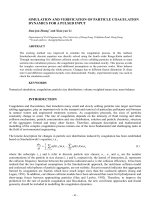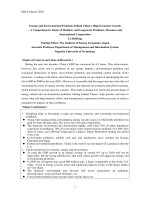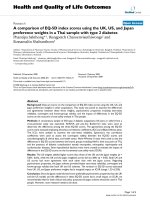A comprehensive solar angles simulation and calculation using matlab
Bạn đang xem bản rút gọn của tài liệu. Xem và tải ngay bản đầy đủ của tài liệu tại đây (1.84 MB, 10 trang )
INTERNATIONAL JOURNAL OF
ENERGY AND ENVIRONMENT
Volume 6, Issue 4, 2015 pp.367-376
Journal homepage: www.IJEE.IEEFoundation.org
ISSN 2076-2895 (Print), ISSN 2076-2909 (Online) ©2015 International Energy & Environment Foundation. All rights reserved.
A comprehensive solar angles simulation and calculation
using matlab
Akram Abdulameer Abood
University of Baghdad, College of Engineering, Department of Energy Engineering, Baghdad, Iraq.
Abstract
During the experimental or theoretical work in the field of solar energy it is found that there is many
parameters need to be estimated or calculated, the calculation procedure of these parameters is long and
dull for students, researchers and designers. This paper introduces the most important parameters such as
solar angles and provides a MATLAB code to calculate these angles at any time and location. Specific
case has been studied to analyze the pattern of solar angles and the solar path. The simulation results
could be a fast reference for orientation of solar energy application, design and sun tracking. Baghdad
city (and any place on 33
o
latitude) chosen for the simulation. different angles and times have been
concluded to determine whether the bests and worsts for solar energy exploitation.
Copyright © 2015 International Energy and Environment Foundation - All rights reserved.
Keywords: MATLAB simulation; Solar angles; Solar energy; Solar path; Sun tracking.
1. Introduction
Recently, interest in alternative energy has been increasing due to rise of oil price by limit of fossil fuels
and environment pollution caused by indiscriminate use of fossil fuels. Compare to traditional energy
sources, the solar energy is limitless and does not generate any pollution emission [1]. The amount of
solar energy that reaches the Earth is well over 1000 times higher than all of the energy we actually use
[2], therefore solar energy is the most promising means to maintain the intensive need for energy.
Primary estimation of solar radiation incident on collector plane is very important to engineers designing
solar energy collecting application, to architects designing buildings, and shadow calculation for the solar
power plants. To meet all these requirements, one should know the amount of radiation falling upon the
collecting surface and its variation over a period of one day and one year.
The amount of the solar radiation incident on a surface is inversely proportional to the value of incidence
angle which is defined as the angle between the solar rays and the normal line on the surface. The
incidence angle can be calculated by a long equation which depends on several angles.
In addition to the importance of determination of the incident solar radiation, the placement of the solar
collector (thermal, electrical) is critical to avoid shading. Especially solar power plants need very large
area, so to minimize the occupied area the spaces between the arrays of the collectors should be kept as
small as possible. The designer must have an idea about the sun path along the year that’s how he will
stay away from array-to-array shading. Shading calculation is important for passive buildings design.
The third thing is enhancing the capturing of the solar radiation by sun tracking system which depends
basically on the sun position prediction.
International Journal of Energy and Environment (IJEE), Volume 6, Issue 4, 2015, pp.367-376
ISSN 2076-2895 (Print), ISSN 2076-2909 (Online) ©2015 International Energy & Environment Foundation. All rights reserved.
368
2. Solar angles and sun position
The solar angle used in the literatures can be classified to two groups.
2.1 sun position in the sky
For most solar energy applications, one needs reasonably accurate predictions of where the sun will be in
the sky at a given time of day and year.
The sun position with respect to an observer on earth can be fully described by means of two
astronomical angles, the solar altitude (α) and the solar azimuth (z). The following is a description of
each angle, together with the associated formulation. Before giving the equations of solar altitude and
azimuth angles, the solar declination and hour angle need to be defined. These are required in all other
solar angle formulations.
1- Declination angle, : The angle between the Sun's direction and the equatorial plane (is the plane of
orbit of the earth around the sun.). varies smoothly from +23.45 º at midsummer in the northern
hemisphere, to -23.45 º at northern midwinter, see Figure 1.
Figure 1. Annual orbital motion of the earth about the sun [2]
Declination angle can be determined by [3]
= 23.45°
360
365
+ 284
(1)
where n is the day in the year (n = 1 on 1 January).
2- Hour angle, h: is the angle through which the Earth has rotated since solar noon. Since the Earth
rotates at 360º/24 hour = 15º/ h. The hour angle is positive in the evening and negative in the
morning, the hour angle is given by [3]:
=
12
15° (2)
3- Solar altitude angle, : The angle between the solar beam and the horizontal.
4- Solar zenith angle, : The angle between the solar beam and the normal on the horizon (Figure 2).
Solar altitude and solar zenith angles are complementing each other( + = 90°) and calculated by [3]:
sin = cos = sin + (3)
International Journal of Energy and Environment (IJEE), Volume 6, Issue 4, 2015, pp.367-376
ISSN 2076-2895 (Print), ISSN 2076-2909 (Online) ©2015 International Energy & Environment Foundation. All rights reserved.
369
where, L is the local latitude, values north of the equator are positive and those south are negative, -90<
L <90.
5- Solar azimuth angle, z: the angle between the solar beam and the longitude meridian. In northern
hemisphere, z equals 0º for a surface facing due south, 180º due north, 0º to 180º for a surface facing
westwards and, 0º to −180º eastward.
sin = cos / (4)
Figure 2. Annual changes in the sun’s position in the sky [4]
2.2 Surafce-sun angles
These angles calculated based on a specified mounting and orientation of the solar collector; Figure 3.
1- Tilt angle, β: is the angle between the plane surface and the horizontal (with 0< β <90 for a surface
facing towards the equator; 90 < β < -90 for a surface facing away from the equator).
2- Surface azimuth angle, Zs : is the angle between the normal to the surface and the local longitude
meridian. Sign convention is as for z. For a horizontal surface, Zs is 0º always.
Figure 3. Zenith angle, angle of incidence, Tilt angle, solar azimuth angle and Surface azimuth angle for
a tilted surface [3]
International Journal of Energy and Environment (IJEE), Volume 6, Issue 4, 2015, pp.367-376
ISSN 2076-2895 (Print), ISSN 2076-2909 (Online) ©2015 International Energy & Environment Foundation. All rights reserved.
370
3- Angle of incidence, : the angle between solar beam and surface normal. is Given by [3]:
= + cosh .
+ + (5)
3. Amount incident solar radiation on the collector surface
Usually, solar energy applications (panels, collectors…) are not installed horizontally but at an angle to
increase the amount of radiation intercepted and reduce reflection and cosine losses. Therefore, system
designers need data about solar radiation on such titled surfaces; measured or estimated radiation data
from the Meteorological Stations, however, are mostly available either for normal incidence or for
horizontal surfaces [5]. Therefore, there is a need to convert these data to radiation on tilted surfaces.
Figure 4 shows the ratio of beam radiation on the tilted surface to that on a horizontal surface at any time
R
b
,[6].
=
=
(6)
=
(7)
Figure 4. Beam radiation on horizontal and tilted surfaces [6]
4. Matlab code
The MATLAB R2014a platform used to calculate all the aforementioned solar angles and the incident
solar radiation on any tilted surface anywhere and anytime.
day=input('Day=');%insert the sequence of the day in the month, from 1 to 31
x=input('Month=');%insert the corresponding number of the month, from 1 to 12
m=[0 31 59 90 120 151 181 212 243 273 304 334];
n=m(x)+day %this step evaluate the day sequence number in the year
declination_angle=23.45*sin(360*(284+n)/365*pi/180) %see equ(1)
d=declination_angle*pi/180;
hour=input('Hour =');%insert the hour in the 24 hour system (e.g. 13 for 1 p.m.)
min=input('Minute=');%insert the minute, from 0 to 59
hour_angle=((hour+min/60)-12)*15 %see equ(2)
h=hour_angle*pi/180;
B=input('Slope(tilt angle)in deg=')*pi/180;
L=input('Local latitude in deg=')*pi/180;
Z=input('Surface azimuth angle in deg=')*pi/180;
%the values above is local and independent.
Daily_optimum_tilt_angle=(L-d)*180/pi
Altitude_angle= asin(sin(L)*sin(d)+cos(L)*cos(d)*cos(h))*180/pi %see equ(3)
a=Altitude_angle*pi/180;
International Journal of Energy and Environment (IJEE), Volume 6, Issue 4, 2015, pp.367-376
ISSN 2076-2895 (Print), ISSN 2076-2909 (Online) ©2015 International Energy & Environment Foundation. All rights reserved.
371
Solar_zenith_angle=90-Altitude_angle
phi=Solar_zenith_angle*pi/180;
Solar_azimuth_angle=asin(cos(d)*sin(h)/cos(a))*180/pi %see equ(4)
z=Solar_azimuth_angle*pi/180;
Incidence_angle=acos(sin(L)*sin(d)*cos(B)-
cos(L)*sin(d)*sin(B)*cos(Z)+cos(L)*cos(d)*cos(h)*cos(B)+sin(L)*cos(d)*cos(h)*sin(B)*cos(Z)+cos(d)
*sin(h)*sin(B)*sin(Z))*180/pi %see equ(5)
theta=Incidence_angle*pi/180;
Gbn=input('Solar radiation on horizontal plane =');
RB=cos(theta)/cos(phi) %see equ(6)
Solar_radiation_on_the_surface=RB*Gbn%see equ(7)
5. Simulation
A MATLAB simulation had been done for Baghdad city and any place all over the world that share the
same latitude (30
o
). the simulation will provide the sun path (Annual and daily solar altitude angle,
Annual and daily solar azimuth angle), also the annual and daily pattern of the solar incidence angle to
obtain the optimum tilt angle and the optimum surface azimuth angle for any day during the year and for
any time during the day.
6. Results and discussion
1- Daily and Annual pattern of the solar altitude angle:
Figure 5a shows how the solar altitude angle changes for four different dates summer solstice (21 June),
winter solstice (21 Dec.), spring equinox (21 Mar.) autumn equinox (21 Sep.), found that in summer the
sun sunrise is the earlier than the others (~5am) and suns elevation is higher for about 60º in solar noon
than winter and about 25º for the equinoxes (see Figure 2). For 21 December the sunrise happens nearly
at 7:00 am.
The solar altitude angle along the year (Figure 5b), six different times in morning to the noon had been
chosen to simulate, found that at the noon the sun elevates higher for about 30º than 9 am in summer. But
in winter the overall sun elevation for all the times is low about 35º at 1 January. See for 6am; the
negative values means that before sunrise and the sun is under the horizon.
Solar altitude angle determine how the collector surface has to be tilting of the horizon.
(a)
(b)
Figure 5. The pattern of solar altitude angle; (a) daily, (b) annual
2- Daily and Annual pattern of the solar azimuth angle:
In Figure 6a, the solar azimuth angle changes for four different dates (21 March, 21 June, 21 Sep and 21
Dec), it was found that in summer, the longest day and a sun tracking system is preferred than winter to
track the sun from the east to the west to capture solar radiation as much as possible (see Figure 2).
International Journal of Energy and Environment (IJEE), Volume 6, Issue 4, 2015, pp.367-376
ISSN 2076-2895 (Print), ISSN 2076-2909 (Online) ©2015 International Energy & Environment Foundation. All rights reserved.
372
The solar azimuth angle along the year (Figure 6b), eight different times in morning to the noon had
been chosen to simulate, found that at the noon the sun is at the south all the year. In summer the
incremental change in the sun position with the time is greater than winter which prove the need for the
tracking system, from 11:30 to 12:00 the sun moves about 30
o
, while in winter just 9
o
.
(a)
(b)
Figure 6. The pattern of solar azimuth angle; (a) daily, (b)annual
3- Daily pattern of the solar incidence angle with different tilt angles:
First of all, it is important to remember that the smaller incidence angle, the better radiation capturing.
Seven different tilt angles as shown in Figure 7, Each of them plotted separately for four dominant dates
and the surface considered to be due to south, to get an idea for how the incidence angle change along the
day. Between the chosen tilt angles 30
o
is the best. Results showed that the Daily optimum tilt angle,
opt
= L as [3, 7].
4- Annual pattern of the solar incidence angle different tilt angles:
A surface oriented to the south and at three times of the day. Four cases of different dates, the pattern of
the solar incidence angles with tilt angles, Figure 8. At 8:00 on the morning, sun tracking system is not
needed for 21 March and 21September because the incidence angle varies ±5
o
along the year. In contrary
for noon time, the incidence angle varies linearly with the tilt angle. In Figure 9, the incidence angle
pattern along the year for five tilt angles. At 8:00, in winter no tracking is needed. The plots prove that
30
o
tilt angle is the best among the chosen tilt angles, which is close to 33o the value of local latitude as
[7, 8].
The tilt angle under 15
o
may not be appropriate when the location is under dusty environment, the
accumulation of dust is faster than tilt angles above 15
o
[4, 9-12].
Duffie and Beckman [3] calculated this angle as
()
= ( + 15) ± 15. Lund [13] achieved this angle
as
()
= ± 15. Heywood [14] obtained the yearly optimum angle as
()
= 10, Qiu and
Riffat [15] found the yearly optimum tilt angle of solar collectors as
()
= ± 10 at a location with
latitude of and the solar energy gain calculated based on the above angles had a relative error below
1.5%. In the above equations, the plus sign is for the northern hemisphere and the minus sign is for the
southern hemisphere.
Figure 10 shows the annual pattern of the change of solar incidence angle with surface azimuth angles 0
o
,
30
o
,45
o
, 60
o
and 90
o
at the noon for several tilt angles. In summer the figure shows that sun tracking
system is not needed at all for the tilt angle except 90
o,
incidence angle varies just about 5
o
that was for
summer, while for winter the effect of azimuth is stronger. (Same result in Figure 11, 21 June).
Four dates and at the noon with different tilt angles β=0
o
, 30
o
, 45
o
, 60
o
and 90
o
in Figure 11.The change
of solar incidence angle with surface azimuth angle, the plot shows that in June sun tracking is not
needed for the change of the surface azimuth angle. In winter (21 Dec.), if the collector oriented to -30
o
to -60
o
then any tilt angle tracking is not needed (similar for the south west).
International Journal of Energy and Environment (IJEE), Volume 6, Issue 4, 2015, pp.367-376
ISSN 2076-2895 (Print), ISSN 2076-2909 (Online) ©2015 International Energy & Environment Foundation. All rights reserved.
373
(a)
(b)
(c)
(d)
(e)
(f)
(g)
Figure 7. The daily pattern of the change of solar incidence angle for four different dates and the surface
oriented to the south and tilted with: (a) β=0
o
(b) β=15
o
(c) β=30
o
(d) β=45
o
(e) β=60
o
(f) β=75
o
(g) β=90
o
International Journal of Energy and Environment (IJEE), Volume 6, Issue 4, 2015, pp.367-376
ISSN 2076-2895 (Print), ISSN 2076-2909 (Online) ©2015 International Energy & Environment Foundation. All rights reserved.
374
(a)
(a)
(b)
(b)
(c)
(c)
Figure 8. The pattern of the change of solar
incidence angle with tilt angle from 0
o
to 90
o
cases
of four different dates and the surface oriented to
the south at (a) 8:00 am, (b)10:00 am, (c) 12:00
noon
Figure 9. The annual pattern of the change of solar
incidence angle with five tilted angles and the
surface oriented to the south at (a) 8:00 am, (b)
10:00 am, (c) 12:00 noon
International Journal of Energy and Environment (IJEE), Volume 6, Issue 4, 2015, pp.367-376
ISSN 2076-2895 (Print), ISSN 2076-2909 (Online) ©2015 International Energy & Environment Foundation. All rights reserved.
375
Figure 10. The annual pattern of the change of
solar incidence angle with azimuth angles 30
o
,45
o
,
60
o
and 90
o
at the noon for tilt angles β=30
o
,45
o
, 60
o
and 90
o
from top to bottom respectively
Figure 11. The change of solar incidence angle
with azimuth angle for different tilt angles β=0
o
,
30
o
, 45
o
, 60
o
and 90
o
for four dates and at the noon
International Journal of Energy and Environment (IJEE), Volume 6, Issue 4, 2015, pp.367-376
ISSN 2076-2895 (Print), ISSN 2076-2909 (Online) ©2015 International Energy & Environment Foundation. All rights reserved.
376
7. Conclusion
The priceless feature of solar energy applications, it consumes free fuel which is the solar radiation.
Unfortunately, the sun is moving continuously. So, Sun Tracking systems are used to keep the sun rays
perpendicular on the solar collector as possible. Trackers add cost and maintenance to the system depend
on if they are simple, complicated and so on. Choosing the right tracker is made after studying the sun
position and how much gain will be earned by installing the tracker.
A solar path and angles simulation was taken for 33
o
latitude (Baghdad city). The results showed that the
annual optimum tilt angle is 33
o
,daily optimum tilt angle
opt
= L ,annual and daily surface azimuth
angle is due to the south for fixed solar collector. Additionally showed the dates and times that solar
tracker is needed and when it is not needed. Also gave the sun position in the sky for shading calculation.
References
[1] Jae-Sub Ko and Dong-Hwa Chung, “Control of a Novel PV Tracking System Considering the
Shadow Influence” Journal of Electrical Engineering & Technology Vol. 7, No. 4, pp. 524~529,
2012,524.
[2] Haberlin, H. (2012). Photovoltaics system design and practice, John Wiley & Sons, Chichester,
West Sussex, United Kingdom. ISBN 978-1-119-99285.
[3] J.A. Duffie, and W.A. Beckman, Solar engineering of thermal processes, John Wiley and Sons
Inc., New York, 2013.
[4] D. H.,W. Li. and T. N., T. Lam. (Determining the Optimum Tilt Angle and Orientation for Solar
Energy Collection Based on Measured Solar Radiance Data); Hindawi Publishing Corporation
International Journal of Photoenergy-Volume 2007, Article ID 85402, 9 pages
doi:10.1155/2007/85402
[5] R. Perez, P. Ineichen, R. Seals, J. Michalsky, and R. Stewart, “Modeling daylight availability and
irradiance components from direct and global irradiance,” Solar Energy, vol. 44, no. 5, pp. 271-
289, 1990.
[6] Kalogirou S. Solar Energy Engineering: Processes and Systems. – Academic Press, 2009.
[7] Gunerhan, H., Hepbasli, A., 2007. Determination of the optimum tilt angle of solar collectors for
building applications. Building and Environment 42, 779-783.
[8] Nakamura, H., Yamada, T., Sugiura, T., Sakuta, K., Kurokawa, K., 2001. Data analysis on solar
irradiance and performance characteristics of solar modules with a test facility of various tilted
angles and directions. Solar Energy Materials & Solar Cells 67, 591-600.
[9] A. A, Hanieh (Automatic Orientation of Solar Photovoltaic Panels) Mechanical Engineering
Department, Birzeit University, Birzeit, Palestine- GCREEDER 2009, Amman-Jordan, March 31
st
-April 2nd 2009.
[10] B. Bruns. (Solar Panel Optimizer – Project description Woods Residence) May 29, 2008.
[11] Owner’s Manual- GE Energy (Solar Electric Power System) -USA- T 302.451.7400- F
302.451.7501.
[12] V.H. Morcos (Optimum tilt angle and orientation for solar collectors in Assiut), Mechanical
Engineering Department, Assiut University, Assiut, Egypt, 2 July 2003.
[13] P.J. Lunde, Solar thermal engineering, John Wiley and Sons Inc, New York, 1980.
[14] H. Heywood, “Operating experience with solar water heating”, IHVE, vol. 39, pp. 63-99, 1971.
[15] G. QIU, and S.B. RIFFAT, “Optimum tilt angle of solar collectors and its impact on performance”,
International Journal of Ambient Energy, vol. 24, pp. 13-20, 2003.
Akram Abdulameer Alkhazzar is a Master’s degree student in the research level at Department of
Energy Engineering/college of engineering/University of Baghdad/ city of Baghdad/ Iraq. He has B.Sc.
from the same department (2011). He worked as an engineer in the Energy Laboratory in the Energy
engineering Department for four years and he shared in the preparation and lecturing of solar energy
experiments. Mr. Alkhazzar’s dominant interests are in the solar energy technologies in heating, power
generation, photovoltaic solar power, passive heating and cooling, thermodynamics and heat transfer.
E-mail address:









